Article | Open Access
A Polyphonic Story of Urban Densification
| Views: | 4000 | | | Downloads: | 2429 |
Abstract: Urban strategies, representing stories of possible futures, often intervene in already established local communities and therefore call for a considerate urban intervention. This article utilises the ideas of Henri Lefebvre’s socially produced space and of literature on stories involved in planning. Our empirical example tells a story of urban densification aspirations for an inner-city neighbourhood in Tampere, Finland. By combining the interviews of local people and planners with policy documents, we argue that planners’ stories pay too little attention to the place and to local stories. Planners’ abstract visions of the future and local stories building on lived experiences both draw meanings from the same place but have very different intentions. In our case, the consultation of the project started out wrong because the planners neglected a neighbourhood thick in symbolic meanings and the local stories’ power in resistance. By understanding the place as polyphonic in its foundation, planners could learn about the symbolic elements and reasons for people’s place attachment, and thus end up re-writing the place together. Urban interventions such as urban densification should connect to the place as part of its polyphonic historical continuum and acknowledge the residents’ place attachments.
Keywords: Henri Lefebvre; place attachment; polyphony; spatial triad; stories; storytelling; urban densification; urban infill
Supplementary Files:
Published:
© Antti Wallin, Helena Leino, Ari Jokinen, Markus Laine, Johanna Tuomisaari, Pia Bäcklund. This is an open access article distributed under the terms of the Creative Commons Attribution 4.0 license (http://creativecommons.org/licenses/by/4.0), which permits any use, distribution, and reproduction of the work without further permission provided the original author(s) and source are credited.


